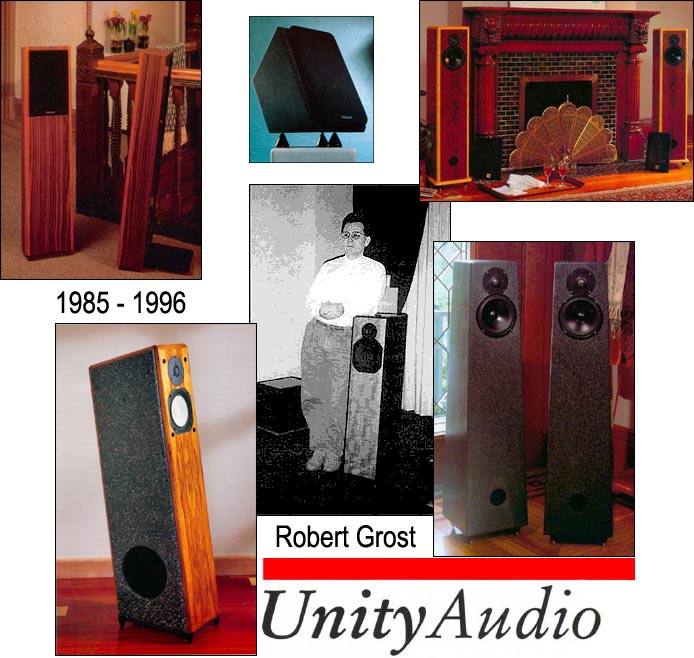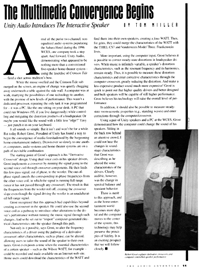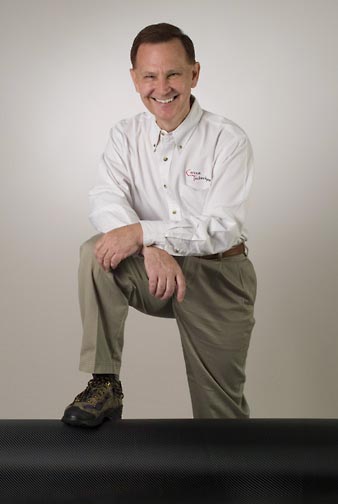 |
||||||||||||||||
 |
||||||||||||||||
|
A brief talk with designer and founder Robert Grost. |
||||||||||||||||
 |
||||||||||||||||
At Unity and as early as 1996 during a Sahara hotel CES presentation, Robert Grost pioneered computer-based convergence via signal correction. He also introduced ceramic composite cones, fluid-coupled enclosures, phase-locked woofer systems, an active balanced Class A low-pass filter for the PARM Professional Application Reference Monitor's subwoofer and the passive, so-called derivative crossover. The latter uses dual voice-coil drivers. The signal from the second voice coil is filtered through a crossover component, then phase inverted and sent to the woofer. This out-of-phase signal cancels the in-phase portion of the full-range (unfiltered) signal from the first voice coil. Presto, a low-pass filtered woofer signal without a network component in the signal that actually drives the woofer. It's a clever way to attain higher signal purity. Computer insertion experiments occurred at the second voice coil leg of the derivative crossover as well. |
||||||||||||||||
 |
||||||||||||||||
| For Cerious Technologies, Robert introduces new Carbon/Kevlar composite loudspeaker hulls with a nouveau external finish and cables that eschew metal conductors by using liquid ceramic-impregnated micro fibers instead. Even the so-called dielectric is unconventional, being a proprietary reactive substance that hovers between a solid and fluid molecular state and actively responds to micro vibrations. |
||||||||||||||||
 |
||||||||||||||||
 |
||||||||||||||||
| Completely handcrafted, each bundle of micro fibers is compressed into a medical-grade Teflon tube whose diameter is contingent on cable length (i.e. a 2-meter cable will use a higher amount of fiber than a 1 meter to insure uniform operating parameters regardless of | ||||||||||||||||
| length). Before insertion into the tube, the fiber bundle passes a saturation bath to first be cleaned, then primed to open up the fibers and improve their absorption coefficient before passing through the proprietary Cerious Liquid Ceramic for full saturation. Subsequently pulling the saturated bundle through the Teflon tube is complicated by the latter's smaller-than-the-bundle diameter. This creates compression for self damping. WBT crimp connections sealed with adhesive-lined heat shrink next seal this sub assembly. The next step involves the feeding of multiple bundles into fiber-reinforced tubing to receive immersion in Cerious Reactive Liquid Ceramic which is modeled after bloodstream platelets and self-healing. This property counters flow and self-anneals the injection of the damping fluid inside the final cable. |
||||||||||||||||
| A custom thinner had to be developed to temporarily inhibit cauterization during the manufacturing process. This thinning agent and the damping fluid are mixed under high speed, then injected. Once the reactive liquid ceramic settles by separating from the thinner, more mixture is poured in. This multi-step repetitive process takes roughly two days per foot of interconnect and thus yields a one-meter interconnect after one week. For balanced interconnects, Chris Sommovigo's Xhadow connector becomes the termination of choice. Immediately before termination, the WBT ends are polished to a high gloss. Next the conductor pins of the Xhadow connectors are machined to reveal a fresh pure layer of OFC copper for high-pressure crimping, then an expanding adhesive seals the connection from oxygen and other contaminates. Even more surprising than the unusual metal-less construction and manufacturing process of the Cerious interconnect is its retail - a mere $750/m/pair for what could be the hi-techiest consumer cable in existence right now. |
||||||||||||||||
 |
||||||||||||||||
 |
||||||||||||||||
The Cerious speaker cables are based on similar principles but adjusted to create the high current low impedance environment necessary for the job. Differentiating between hot and return conductors, the negative leg uses a combination of metal and composite conductors while the positive leg is purely composite. The same reactive ceramic compound used in the interconnects then surrounds both legs for self-damping and shielding. A digital interconnect and power cords are just about to be launched as well. Moonie Edgar Kramer will do the honors on reporting what happens when you get completely cerious. Yours not so truly meanwhile will juxtapose the Cerious interconnect against the lauded Stealth Indra to investigate whether the state of the art has since moved on (and gotten significantly cheaper to enjoy). Interview with Robert Grost to follow shortly in Part 2. |
 |
|||||||||||||||
 |
||||||||||||||||
|
Manufacturer's website
|
||||||||||||||||
 |
||||||||||||||||